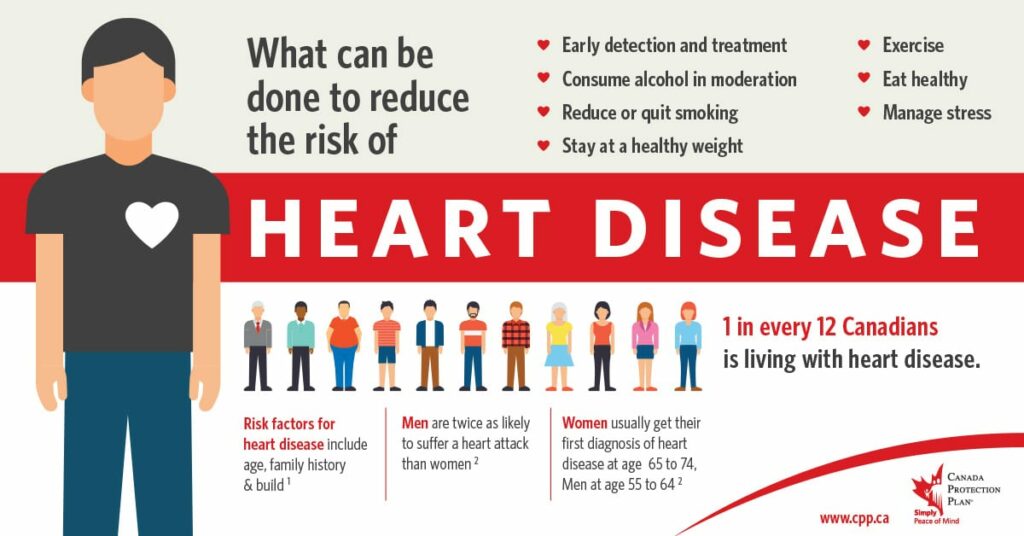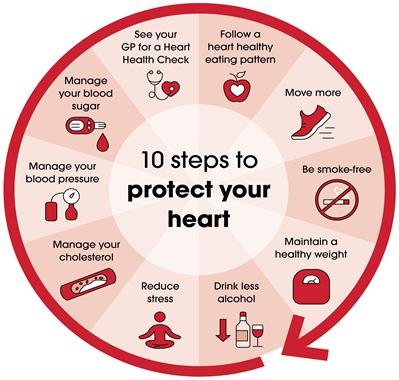Preventing Heart Attacks in Canada: Risk Factors and Early Intervention
A heart attack happens when the blood flow to the heart is blocked depriving the heart of much-needed oxygen. It is a medical emergency, and it is necessary to go to the hospital immediately when the first signs of any of the symptoms are noticed. This can also be called myocardial infarction, and it can cause lasting damage to the affected muscles of the heart. Tips on preventing heart attacks in Canada, knowing the risks factors and early intervention plans will be discussed here.

What are some of the ways of preventing heart attacks?

While it is not possible to change some of the risk factors that cause heart attacks like family history, age or sex, it is possible to take steps that will prevent its occurrence or at least reduce the risk of it occurring. Some of these preventive steps include:
Quit smoking and tobacco use
Stopping smoking and use of smokeless tobacco is one of the best things that an individual can do to protect and preserve the health of their heart. Even non-smokers should do well to stay away from second-hand smoke. The chemicals in tobacco can cause damage to the heart and the blood vessels, while cigarette smoke lowers the oxygen in the blood. This reduction in the oxygen level raises the blood pressure and heart rate as the heart works more to circulate the available oxygen to the body and the brain. It is important to quit as soon as possible no matter how long the person has been smoking; this is because the risk of heart disease drops after only a day of quitting. After about a year without smoking, the risk drops to about half that of a smoker.
Healthy eating
This is very important; a healthy diet can help in improving the heart, the blood pressure and the cholesterol levels. It can also lower the risk of type 2 diabetes. It is important to include vegetables, beans or other legumes in the diet. Whole grains are also important in the diet, as well as lean meats and more fish. An individual should eat more healthy fats like olive oil and avocado and less saturated fats like seen in red meat, full-fat dairy, palm oil and coconut oil. They should also avoid high-sodium meals and salt, sugary beverages, highly refined carbohydrates, highly processed meals, trans-fat and alcohol.
Sleeping well
People who lack good sleeping habits are more at risk of obesity, heart attack, diabetes, high blood pressure and depression. Adults need about 7-8 hours of sleep, children need more, so it is important to set a sleep schedule and stick to it. It is also crucial to consult with a health care team if an individual feels that they are not getting enough sleep or that they still feel tired no matter how long they sleep. They can enquire if they need evaluation for obstructive sleep apnea which can raise the risk of risk of heart disease.
Be active
Regular and daily physical activity can greatly reduce the risk of heart disease. Physical activity helps in controlling the weight of an individual. This lowers the chances of that individual developing diseases that can stress the heart like high blood pressure, high cholesterol and diabetes. An individual should aim for around 150 minutes a week of moderate aerobics like walking and jogging. Around 75 minutes a week of vigorous aerobics like running and around two sessions of strength training sessions a week. Even if an individual cannot meet these guidelines, they should still try to get shorter bouts of activity; even just five minutes of activity can help greatly. Activities like housekeeping, gardening, dog walking and other mild forms of daily activities can all count. It must not be hard exercises, though the benefits are more when they are intense and frequent exercise.
Maintaining a healthy weight
When an individual is overweight, especially in the middle of their body, their risk of heart disease increases. Extra weight can increase the risk of heart disease. This is because it leads to conditions that can lead to heart diseases like diabetes, high blood pressure, etc. A BMI of 25 or higher is considered overweight and this is linked to higher cholesterol and an increased risk of stroke and heart disease.
Waist circumference can also be a useful tool in measuring just how much belly fat an individual has. The risk of heart disease is higher when the waist measurement is greater than 40 inches for men and 35 inches for women. Reducing the weight through various means by as little as 3-5% can help lower the level of certain fats in the blood called triglycerides. It can also lower blood sugar and this cuts the risk of the individual developing diabetes. Losing, even more, can help lower blood pressure and blood cholesterol.
Prevent infection
Certain infections can lead to heart problems. For example, gum disease can be a risk factor for heart and blood vessel diseases. So getting dental check-ups and keeping good oral hygiene is very important. Other sicknesses from infections can also make existing heart problems worse. Vaccines can also help in the prevention of infectious diseases, so it is important to stay up to date on vaccine shots like flu vaccines, pneumococcal vaccines, and other important vaccines. An individual can get a list of the vaccines they should take from their healthcare provider.
How can an individual get an early intervention to prevent heart attacks?
It is important to get regular health screening tests. This can help to indicate if there is a problem like high blood pressure and high cholesterol which can damage the heart and blood vessels. Regular screening can help the individual to know their numbers and if they need to take action. An individual should regularly check for the following:
Blood pressure
Regular screenings for blood pressure is very important. They should be taken at least once every year. This test checks for high blood pressure which is a risk factor for heart disease and stroke. Individuals between the ages of 18-39 and who have risk factors for high blood pressure should be screened at least once every six months. Older people should be screened more frequently.
Cholesterol levels
It is recommended that cholesterol screenings should start between the ages of 9 and 11. Earlier screenings may be considered if the person has risk factors like a family history or an early onset of heart disease. After the first screening, it should be repeated once every five years, though the timing changes with age. Individuals above the age of 45 should be screened every year at least.
Type 2 diabetes screening
This disease raises the chances of getting a heart disease and a heart attack. The risk factors for diabetes include being overweight and a family history of the disease. An early screening is recommended if any of the risk factors are present. If they are not, healthcare providers will usually recommend screenings start from 45 years of age. Then the blood sugar levels should be screened every three years.
The presence of high levels of the above-listed parameters would necessitate intervention from the individual’s healthcare team. They may prescribe lifestyle changes or some medication which will be beneficial to the person. These can then prevent the occurrence of heart attacks in that individual.
The information provided in this blog is for educational purposes only and should not be considered as medical advice. It is not intended to replace professional medical consultation, diagnosis, or treatment. Always consult with a qualified healthcare provider before making any decisions regarding your health. Read more







